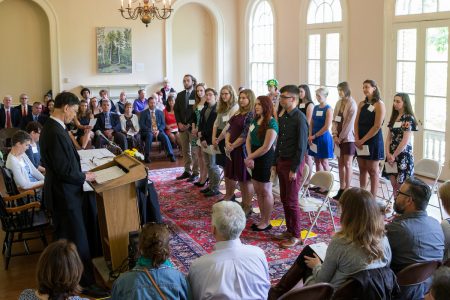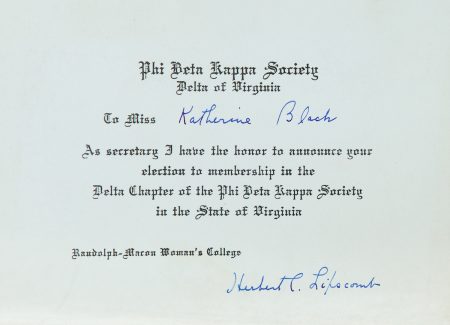Celebrating a century of Phi Beta Kappa membership

Class of 2017 Phi Beta Kappa induction ceremony.
In 1916, Randolph-Macon Woman’s College became the 88th institution in the nation—and the first woman’s college in the South— to become a member of Phi Beta Kappa, the nation’s oldest and most prestigious academic honor society for the liberal arts and sciences. Today, Randolph College continues to induct its highest quality graduates into the Delta of Virginia Chapter of Phi Beta Kappa, which is currently celebrating its 241st anniversary through Keys to Action Week.
Over the years, around 1,300 Randolph alumnae and alumni have received the honor. The College initiates around 10 percent of each graduating class based on the society’s guidelines, which is generally about 12-15 students. The first inductees were 1917 graduates Cornelia Frost, Florence I. Kehr, Catherine Hunter Nuckols, Henrietta Peery, and Mary Louise Petrie. Fourteen graduates in the Class of 2017 were offered membership.
To be offered membership, students must meet the requirements for a solid liberal arts degree, have achieved a certain number of credits at Randolph and a minimum GPA, and meet the requirements for math and language.
“Randolph students offered membership in Phi Beta Kappa are very strong academically and tend to have other attributes that suggest they have been identified as good citizens within the community,” said Kim Sheldon, director of student success.
Phi Beta Kappa was initiated as a society on December 5, 1776 by five students at the College of William and Mary in Williamsburg, Va. Yale and Harvard were granted charters prior to the Revolutionary War, and chapters grew during the 19th century. Today there are 286 chapters, and only 10 percent of U.S. colleges and universities are members.
An excerpt from the 1918 Helianthus regarding the installation of Phi Beta Kappa:
“The movement to secure a charter for Randolph-Macon Woman’s College was inaugurated in 1911 by Dr. W.W. (William Waugh) Smith, who was a member of the Virginia Beta Society. Associated with him were Dr. Herbert C. Lipscomb, (Alpha of Maryland), Professor of Latin, and Dr. Gustav G. Laubscher, (Alpha of Ohio), Professor of Romance Languages. It was a matter of congregation to the friends of the College that the application which was presented to the Senate in March 1913 contained the endorsements of many of the strongest universities and colleges in the country, including the College of William and Mary, the University of Virginia, Washington & Lee University, Vanderbilt University, and the Johns Hopkins University, institutions by reason of their proximity would naturally be best acquainted with the standards and ideals obtaining in the Woman’s College. It was a pleasure also to include the endorsement of the General Education Board, given through its secretary, Dr. Wallace Bultrick, who under date of May 23, 1912, wrote: ‘Our office has carefully examined Randolph-Macon Woman’s College, both as to its equipment and standards, and one of the chief representatives in the South in the field of higher education of women.’

This Phi Beta Kappa certificate was awarded to Katherine Black in the early 1900s.
“The Senate took favorable action upon the application, and included Randolph-Macon Woman’s College in the list of institutions recommended to the next session of the National Council as worthy of charters. The first battle in behalf of the coveted honor was won, but in view of the fact that a successor to Dr. Smith who had passed away during the preceding November, had not been elected, Drs. Lipscomb and Laubscher, at the suggestion of the secretary of the United Chapters, requested that that application lie over without prejudice until the Council of 1916, and this action was taken.
“In the meantime, Dr. William A. Webb, (Alpha of Tennessee), President of Central College, Fayette, Missouri, was elected to succeed Dr. Smith. He entered upon his duties with the opening of the Fall term, in 1913, and in cooperation with the other signers continued the campaign in behalf of the charter. In September 1916, the application, with the added signatures of President Webb, Professor Clarence E. Leavenworth, (Epsilon of New York), and Miss Edith Claire Comstock, (Zeta of Massachusetts), was presented to the Twelfth National Council, with Professor James Lewis Howe, of Washington & Lee University, as spokesman, and a charter was granted without a single dissenting vote. This happy consummation was no doubt due in part at least, to the reports made by the distinguished president of the United Chapters of Phi Beta Kappa, Dr. E.A. Grosvenor, and Senator Mary E. Woolley, President of Mount Holyoke College, who were guests of the College in the Spring of 1916, and were able to speak at first hand of the impressions made by the personnel of the faculty, the value and extent of the physical equipment, and the representative character of the student body.”
Tags: alumnae, alumni, honor societies, Kim Sheldon, Phi Beta Kappa
